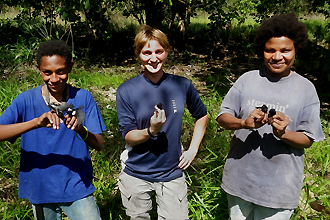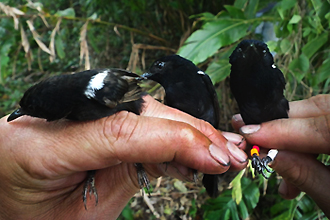Flashy wrens buck fashion trends
Tiny female wrens commonly found in gardens of Papua New Guinea are the subjects of intense scientific interest. Jenny Hazlehurst, a doctoral student in the Tulane Department of Ecology and Evolutionary Biology, has received a National Geographic Young Explorer grant to study a specific species of fairy wren.

Jenny Hazlehurst, center, works with local parabiologists in Papua New Guinea to put leg bands on fairy wrens so they can be tracked. (Photos from Jenny Hazlehurst)
This fairy wren is fascinating, Hazlehurst says, because the females display black-and-white markings that are similar to the males' plumage. Across the aviary kingdom, the color of a female's feathers is typically drab when compared to her male counterpart. Most evolutionary experts agree that the males tend to be flashier dressers in order to attract the attention of females. A male cardinal is bright red, but the female is dull brown. A male peacock's tail feathers are legendary.

A specific species of fairy wren makes a fascinating study subject, Jenny Hazlehurst says, because the females display black-and-white “tuxedo” markings that look like the males.
Some of the female fairy wrens follow suit, wearing a drab color. But other females in the species Hazlehurst is studying prefer the tuxedo look.
“Darwin wrote off cases like this which are less common. It is rare to have females show variation from drab to colorful, but not as rare for males and females to be always identical,” says Hazlehurst. She and her adviser, Jordan Karubian, assistant professor, have a different hypothesis.
While conventional thought regarding sexual selection is that males intent on mating must compete for females, Hazlehurst says, “in areas where the females share plumage coloration with males, we think that these females have to compete with each other for males.”
Next summer Hazlehurst will return to Papua New Guinea, where she and a team of local parabiologists will track the comings and goings of the little birds, tagging them with tiny leg bands. They will observe the black-and-white females to see if they are more aggressive than the females with drab feathers. Their behavior will be scrutinized, with observations about mating, nesting and the function of female plumage color.
Hazlehurst hopes the clues will lead to answers about what is affecting female coloration, possibly lending a new shade of interpretation of Darwin's theory of sexual selection.
